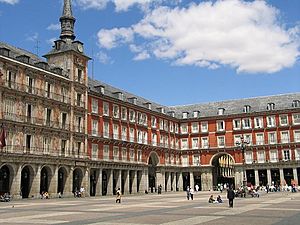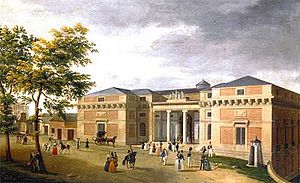Juan de Villanueva facts for kids

Juan de Villanueva (born September 15, 1739, in Madrid; died August 22, 1811) was a famous Spanish architect. He is known as one of the most important architects of the Neoclassical style in Spain. This style brought back ideas from ancient Greek and Roman art.
Juan de Villanueva's Life Story
Juan de Villanueva's father was a sculptor, also named Juan de Villanueva. His brother, Diego de Villanueva, was very important in his life. Diego helped him and also taught him.
Juan started studying at the Royal Academy of Fine Arts of San Fernando when he was just eleven years old. In 1758, he received a special scholarship from the Academy. This allowed him to travel to Rome to finish his studies. He returned to Spain in 1765.
A year later, he traveled through cities like Córdoba and Granada. There, he worked with José de Hermosilla to draw old "Arab antiquities." These drawings were later published in 1804. After his travels, he settled in Madrid. He was then made an Academic at the Academy of San Fernando.
In 1777, King Charles III gave him an important job. He became the Architect for the Prince and the King's children. From this time until he died, he worked mostly for the Royal Family. In 1781, he became the Architect of the Royal Monastery of El Escorial. Later, King Charles IV made him the Major Architect.
He designed several buildings for the Royal Family:
- In 1771, he built the Casa de Infantes (House of the Infants) in Aranjuez.
- In 1772, he built the Casita del Príncipe (Little House of the Prince) at El Pardo.
- In 1773, he designed the Casita de Arriba (Upper Little House) and the Casita de Abajo (Lower Little House), also called del Príncipe, both in El Escorial. The Casita de Arriba had a special design and a beautiful main entrance.
- At El Escorial, he also built the Casas de Oficios (Houses of Trades). These were a group of houses built in a simple style, similar to the Monastery itself.

However, his most famous work is the Prado Museum in Madrid. He designed it between 1785 and 1787. It was first planned to be a Museum of Natural History. It was also meant to be a school for natural history and a place for lectures. In 1814, it was changed into an art museum. Today, it is also known as the Edificio Villanueva (Villanueva Building).
Juan de Villanueva was a very busy architect. Most of his work can be seen in Madrid. Important buildings he designed include the Academy of History, the Caballero de Gracia oratory, and the Astronomical Observatory. He also helped to redesign the Plaza Mayor after a big fire in 1790. He was buried in San Sebastian church in Madrid.
With his unique style and local influences, he was the architect who best brought the ideas of European Neoclassicism to Spain.
Main Buildings by Juan de Villanueva


Here are some of Juan de Villanueva's most important works:
- Casita de los Infantes, Aranjuez (1771)
- Casita de arriba, El Escorial (1773)
- Casita de abajo, El Escorial (1773)
- Royal Botanical Garden, Madrid (1774-1781)
- Casita del Príncipe, El Pardo (1784)
- Casa de los Oficios, El Escorial (1785)
- Prado Museum, Madrid (1785)
- Academy of History, Madrid (1788)
- Oratory of Caballero de Gracia, Madrid (1789)
- Major House of Madrid: Columned façade to the Calle Mayor, Madrid (1789)
- Astronomical Observatory, Madrid (1790)
- Reconstruction of the Plaza Mayor, Madrid (1791)
- Príncipe Theater, Madrid (1804)
- General Cemetery of the North, Madrid (1804)
See also
 In Spanish: Juan de Villanueva para niños
In Spanish: Juan de Villanueva para niños

